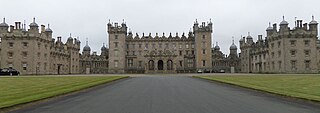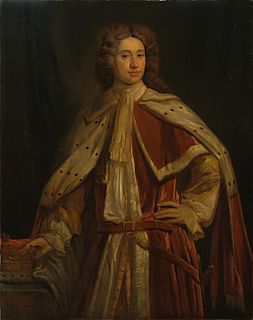
The Duke of Roxburghe is a title in the peerage of Scotland created in 1707 along with the titles Marquess of Bowmont and Cessford, Earl of Kelso and Viscount Broxmouth. John Ker, 5th Earl of Roxburghe became the first holder of these titles. The title is derived from the royal burgh of Roxburgh in the Scottish Borders that in 1460 the Scots captured and destroyed.

Marquess of Lothian is a title in the Peerage of Scotland, which was created in 1701 for Robert Kerr, 4th Earl of Lothian. The Marquess of Lothian holds the subsidiary titles of Earl of Lothian, Earl of Lothian, Earl of Ancram (1633), Earl of Ancram, Viscount of Briene (1701), Lord Newbattle (1591), Lord Jedburgh (1622), Lord Kerr of Newbattle (1631), Lord Kerr of Nisbet, Langnewtoun, and Dolphinstoun (1633), Lord Kerr of Newbattle, Oxnam, Jedburgh, Dolphinstoun and Nisbet (1701), and Baron Ker, of Kersheugh in the County of Roxburgh (1821), all but the last in the Peerage of Scotland. As The Lord Ker in the Peerage of the United Kingdom, previous marquesses sat in the House of Lords before 1963, when Scottish peers first sat in the House of Lords in their own right. The holder of the marquessate is also the Chief of Clan Kerr.
Robert Ker, 1st Earl of Roxburghe was a Scottish nobleman.

Floors Castle, in Roxburghshire, south-east Scotland, is the seat of the Duke of Roxburghe. Despite its name it is an estate house rather than a fortress. It was built in the 1720s by the architect William Adam for Duke John, possibly incorporating an earlier tower house. In the 19th century it was embellished with turrets and battlements, designed by William Playfair, for The 6th Duke of Roxburghe. Floors has the common 18th-century layout of a main block with two symmetrical service wings. Floors Castle stands by the bank of the River Tweed and overlooks the Cheviot Hills to the south.

John Ker, 1st Duke of Roxburghe, KG, PC, FRS was a Scottish nobleman.

Clan Colville is a Lowland Scottish clan.

Clan Moncreiffe is a Highland Scottish clan.

Sir William Douglas "le Hardi", Lord of Douglas was a Scottish nobleman and warlord.

Halydean is a Scottish feudal Crown Barony and Lordship in Roxburghshire in the neighbourhood of Kelso, in the Borderlands of Scotland, along the River Tweed. This area along the Tweed is home to the Scottish border clans, including the Armstrongs, Douglases, Elliots, Johnstones, Kers, Moffats, and many others. The Barony and Lordship of Halydean (Holydean) is one of the oldest Norman feudal baronies in Scotland with a living claimant.
Alexander Fraser, 11th Lord Saltoun, was a Scottish peer and the 10th Laird of Philorth.

Clan Innes is a Highland Scottish clan. The clan is without a chief that is recognized by the Lord Lyon King of Arms; therefore it can be considered an armigerous clan. The clan takes its name from the lands of Innes in Moray, Scotland.
Andrew Stewart, 1st Baron Castle Stuart (1560–1629) was a Scottish nobleman, soldier, courtier to King James VI and I and one of the chief undertakers in the Ulster Plantation.
The Decreet of Ranking of 5 March 1606 determined the relative precedence of members of the peerage of Scotland.

The Barony of Glengarnock is a Scottish feudal barony in the county of Ayrshire in Scotland.

Stobo is a title in the Baronage of Scotland which takes its name from Stobo in the Scottish Borders.
James Stewart, 4th Lord Ochiltree was a 17th-century Scottish noble.
Robert Ker, 3rd Earl of Roxburghe PC was a Scottish nobleman.
William Bellenden-Ker, 7th Lord Bellenden, 4th Duke of Roxburghe was a Scottish nobleman.
John Bellenden, 2nd Lord Bellenden was a Scottish nobleman.
Alexander Abernethy, 6th Lord Saltoun was a Scottish landowner and courtier.